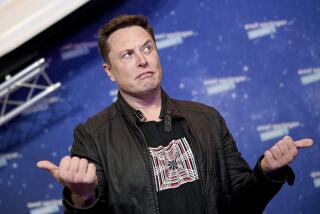SpaceX rocket achieves sea landing, setting up Elon Musk’s firm to dominate
Elon Musk’s SpaceX successfully landed a booster rocket on a drone ship for the first time Friday, a milestone that could lessen the cost of delivering cargo to space and place the Hawthorne company in position to dominate the commercial launch services market.
The Falcon 9 stage touched down on the drone ship, called Of Course I Still Love You, moored in the Atlantic Ocean off Cape Canaveral, Fla., shortly after hurling a payload destined for the International Space Station. It was the company’s fifth attempt at a sea landing — the most recent failure came last month after a commercial payload launch from the same site.
“The rocket landed instead of putting a hole in the ship or flipping over, so we’re really excited about that,” said Musk, who has shown unusual humor through previous failures — after a January explosion off the California coast, he tweeted, “at least the pieces were bigger.”
In December, SpaceX’s first-stage booster landed upright on solid ground at Cape Canaveral, itself a milestone. Musk said he’ll feel like he’s achieved the next level “when it becomes boring, when it’s like, ‘another landing, no news there.’”
For a new generation of space flight engineers and aficionados, the milestone was akin to the televised coverage of Apollo missions. Space Exploration Technologies Corp. employees, NASA officials and a massive Internet audience watched a live video feed that showed the rocket arcing down to the ship, landing upright, and then just standing still — other rockets had toppled and erupted in a fireball. The crowd erupted in applause, followed by chants of “USA.”
“I have a confession to make — I did, indeed, hug Hans,” said Musk, referring to Hans Koenigsmann, the company’s vice president of mission assurance. “The whole SpaceX team was super excited. They’ve all worked incredibly hard to get to this day.... Making the landing and re-flight easy is hard,” Musk said.
About a third to half of the company’s missions will necessitate ocean landings, making the milestone key to SpaceX’s effort to accelerate the pace of launches by reusing equipment, according to Musk, who said he would like to match the three-hour turnaround of a cross-Atlantic 747 flight.
The sea landings are crucial because the weight, fuel and speed requirements to deliver certain payloads make it difficult to return the stage to the original launch zone.
Musk said the company will inspect the rocket stage and test its engines, with the goal of reusing it as early as June. The stage that successfully landed at Cape Canaveral in December was saved for display at SpaceX’s Hawthorne headquarters.
SpaceX’s nearest competitor, Jeff Bezos’ Blue Origin, has reused its rocket in three test flights, but has yet to do so in a commercial flight with a payload.
Marco Caceres, senior space analyst for Teal Group Corp., a defense and aerospace analysis company based in Fairfax, Va., said he was not surprised by Friday’s landing, given Musk’s tenacity in risking public failures.
“Ultimately it was a matter of time,” he said. “He was totally committed to this. He’s committed to reusable technology.”
SpaceX already offers a much cheaper price for launches, Caceres said. If Musk can regularly reuse the first stage, “pretty much everybody will be eating his dust,” Caceres said.
Eric Stallmer, president of the Commercial Spaceflight Federation, the trade group for the nascent industry, said the landing was “a great step forward.”
“The next step for SpaceX would be to take a good look at this engine and stage and see what needs to be done — does it need an overhaul, or does it test out and need a new paint job?” Stallmer said.
If SpaceX can reuse the stage, “I think you’ll see a potential cost savings of 30% off the original launch cost, and that price will continue to drop with the success of this,” he added.
Publicly traded corporations in the launch services market can’t afford to “fail publicly” as the privately held SpaceX had, Caceres said, because they risk losing stock value.
“He doesn’t consider these failures; he considers this research and development,” Caceres said.
With a launch price that is about 50% to 70% that of its competitors, SpaceX already is dominating the NASA market and is making inroads into military missions, Caceres added.
The payload is expected to dock Sunday with the space station in what would be the Hawthorne company’s first trip to the space station since last April. An attempt in June failed when a rocket disintegrated just minutes after liftoff.
The Falcon 9 rocket launched the Dragon payload loaded with 7,000 pounds of supplies for the space station’s crew. Among those supplies are materials to assist with dozens of about 250 onboard science and research investigations, SpaceX said.
This is SpaceX’s eighth mission to the space station out of 20 that the company is contracted to fly for NASA. SpaceX blamed the Falcon 9 disintegration last June on a faulty strut that held down one of many helium bottles on the rocket’s second stage, where the explosion occurred.
Times staff writer Lauren Raab contributed to this report.
More to Read
Inside the business of entertainment
The Wide Shot brings you news, analysis and insights on everything from streaming wars to production — and what it all means for the future.
You may occasionally receive promotional content from the Los Angeles Times.











